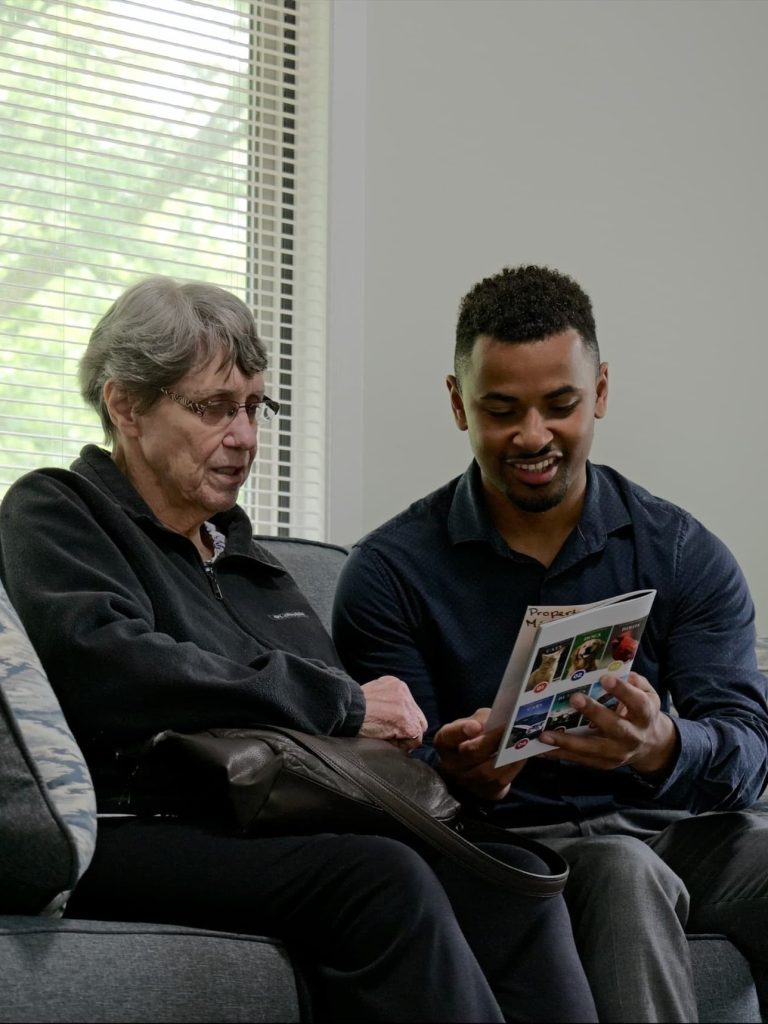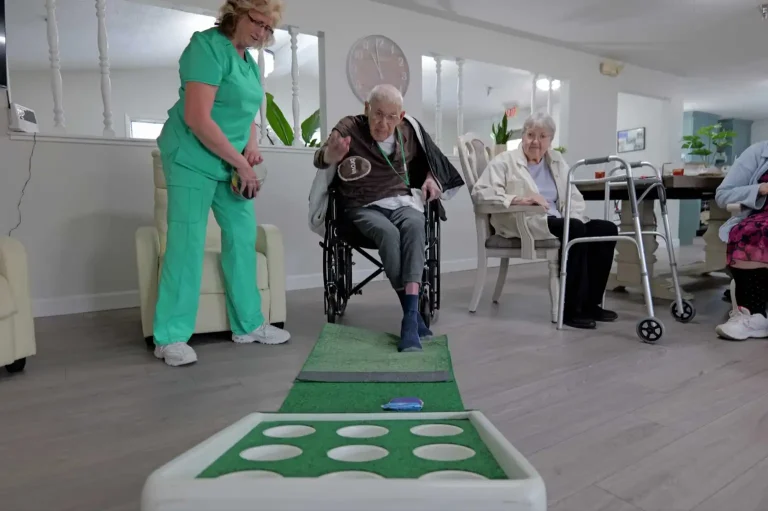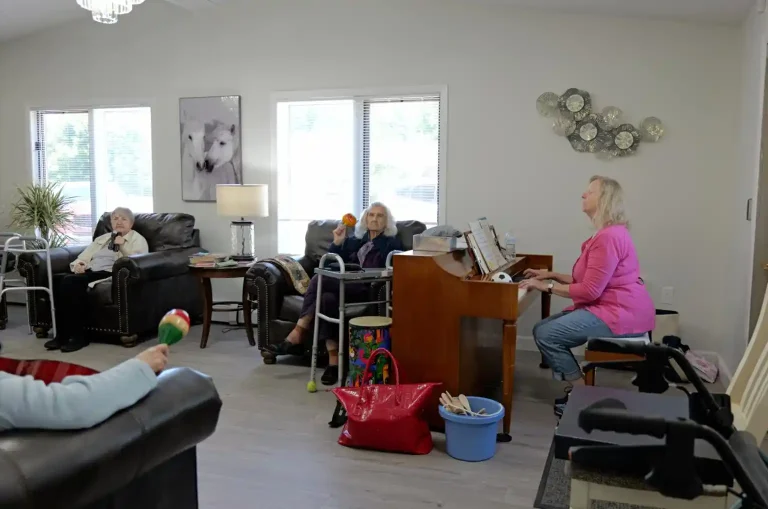A Guide To Choosing a Memory Care Community

Choosing the right memory care community for a loved one can be an overwhelming task, especially when navigating the complexities of Alzheimer’s and dementia care, including understanding the specific care needs and safety features required.
This guide offers insights into what memory care communities provide, including specialized care, safe environments, and enriching activities, while considering the cost of care and facility amenities.
We cover essential factors to consider when selecting a community, the costs involved, tips for a smooth transition, and the importance of family involvement and caregiver support.
Discover how Patient Pines Assisted Living in Green Bay, WI, can make a difference in your loved one’s journey, offering specialized meals, memory-enhancing therapies, and support groups for caregivers.
Key Takeaways:
Consider location and accessibility, staff qualifications and training requirements, facility amenities and services offered, and reputation and quality of care when choosing a memory care community, utilizing a memory care checklist for guidance.Prepare for the move by involving your loved one in the decision-making process, planning ahead, and making necessary arrangements for finances and personal needs, with financial advice from healthcare professionals.When touring and evaluating a memory care community, schedule a tour, ask questions, observe the community, review the contract and visitation policies, and engage with caregiving staff to understand memory care options.
What is a Memory Care Community?
A Memory Care Community is a specialized care facility designed to cater to individuals suffering from cognitive decline, such as dementia and Alzheimer’s disease, ensuring they receive the necessary support, safety, and engagement that their unique needs require, including dementia care training for staff. Located in Green Bay, WI, Patient Pines Assisted Living exemplifies the features of a memory care community by providing tailored therapies, quality of life enhancement, and a secure environment that promotes resident well-being. These communities focus on delivering round-the-clock care while integrating community resources to foster meaningful interactions, emotional support, and resident interaction among residents and caregivers.
Why Choose a Memory Care Community?
Choosing a memory care community is vital for families seeking specialized care for their loved ones with dementia or Alzheimer’s disease, as these facilities provide tailored support, including memory care programming and tailored therapies, that enhances quality of life and ensures resident safety. The selection of a memory care community, such as Patient Pines Assisted Living in Green Bay, WI, is grounded in the understanding that caregivers and family members require not only caregiving support but also emotional backing during this challenging journey. The engagement activities and emotional support offered in these communities create a nurturing atmosphere that fosters personal growth, social interaction, and encourages participation in community activities.
Specialized Care for Alzheimer’s and Dementia
Specialized care for Alzheimer’s and dementia is a cornerstone of memory care communities, focusing on the individual needs of residents through tailored therapies and memory care programming designed to enhance cognitive function and emotional well-being. This approach not only addresses the medical aspects of care but also fosters an environment conducive to meaningful interactions and enhances quality of life for residents suffering from cognitive decline.
Memory care facilities implement specialized care through a variety of programs and therapies designed to engage residents at different stages of cognitive decline. These facilities often utilize:
- Reminiscence therapy, which encourages residents to recall and share memories, promoting cognitive engagement while enhancing emotional connections.
- Structured daily living routines that provide consistency, reducing anxiety and confusion for those with memory challenges.
- Art and music therapy programs that stimulate cognitive function and allow for self-expression, often resulting in therapeutic outcomes.
Caregivers are trained in specialized communication techniques, ensuring that interactions support the residents’ dignity and sense of self, ultimately facilitating a supportive and nurturing environment.
Safe and Secure Environment
A safe and secure environment is paramount in memory care communities, ensuring that residents are protected from wandering and other potential hazards while still allowing them to engage in daily living activities, supported by skilled nursing staff. Facilities like Patient Pines Assisted Living are equipped with specialized safety features and protocols, including therapeutic gardens and light therapy, designed to mitigate risks, providing peace of mind to families and caregivers alike.
These communities implement a variety of innovative safety measures that directly enhance residents’ well-being and comfort. For instance, physical designs often include:
- Secure access points that are monitored and controlled, reducing the likelihood of residents wandering off.
- Memory-friendly layouts that facilitate easy navigation, equipped with distinct colors and textures to aid in orientation.
- Emergency call systems placed strategically throughout the facility, ensuring that help is always within reach.
Staff members receive specialized training to recognize the unique needs of residents, fostering a caring environment where individuals feel valued and safe. The combination of these thoughtful designs and safety protocols not only prevents accidents but also encourages social interaction and independence, contributing to a holistic sense of security and well-being.
Social and Recreational Activities
Social and recreational activities play a crucial role in memory care communities, offering residents opportunities for engagement and interaction that can significantly enhance their emotional and cognitive health.
At Patient Pines Assisted Living, a variety of personalized activities are planned to align with resident preferences, fostering a sense of community and belonging that is essential for those experiencing cognitive decline.
Engaging in these activities not only helps to stimulate the mind but also encourages socialization, which is vital for maintaining mental vigor. For instance, participation in group games, arts and crafts, and music therapy can spark feelings of joy and connection among residents. Such interactions form the backbone of cognitive health by:
- Enhancing Communication Skills: Regular engagement offers opportunities to practice verbal and non-verbal communication.
- Boosting Mood: Social settings evoke positive emotions, reducing feelings of isolation and depression.
- Facilitating Memory Recall: Familiar activities can help jog memories, reinforcing cognitive abilities.
Ultimately, these enriching experiences not only uplift spirits but also contribute to the overall quality of life for residents facing the challenges of memory decline, supported by gerontologist advice and skilled nursing care.
Nutritious Meals and Personalized Care Plans
Nutritious meals tailored to individual personal needs are fundamental in memory care communities, ensuring that residents not only receive essential nutrition but also enjoy meals that cater to their specific dietary requirements and preferences.
In a care facility such as Patient Pines Assisted Living, personalized care plans are developed to include specialized meals that promote health and enhance overall well-being, tailored to resident preferences and dietary needs.
These specialized meal plans form a crucial part of the overall care strategy, significantly contributing to cognitive function, emotional stability, and addressing specific care needs. By understanding each individual’s culinary likes and dislikes, staff are able to create a dining experience that is not only nourishing but also enjoyable. This attention to detail can help foster a sense of normalcy and comfort in a challenging phase of life.
- Nutrition plays a pivotal role in maintaining residents’ health, addressing issues such as weight management and dietary restrictions.
- Meal planning is integrated into personalized care plans, ensuring choices that align with each resident’s unique health needs.
- Caregivers monitor hydration levels and nutritional intake closely, adapting meals as necessary.
Ultimately, by prioritizing nutrition and personalized meal preparation, memory care communities make significant strides in improving both physical and mental health, which is essential for engaging residents in their daily activities.
What to Consider When Choosing a Memory Care Community?
When choosing a memory care community, it’s essential to consider various factors, such as the specific care needs of your loved one, the community’s reputation, staff training qualifications, and overall quality of care provided, using an assessment guide to evaluate memory care options. In Green Bay, WI, families must utilize an assessment guide to evaluate the essential features, including location and accessibility, safety protocols, and visitation policies that contribute to a supportive environment for residents with cognitive decline.
Location and Accessibility
The location and accessibility of a memory care community are critical factors that influence the decision-making process for families seeking care for their loved ones. A conveniently located care facility, with easy access to community resources, ensures that family members can frequently visit and provide support to their loved ones while also allowing residents to engage in community activities and benefit from caregiver support.
In many cases, distance can deter families from being involved in daily care routines, which significantly impacts both emotional well-being and social engagement.
Having a facility situated near parks, shops, and healthcare services fosters a sense of normalcy and connection with the outside world, enhancing quality of life and resident well-being.
- Access to local amenities enhances the quality of life for residents while also making it easier for families to join recreational activities.
- Participating in local events can decrease feelings of isolation that often accompany memory impairment, providing a personalized decision-making process for residents.
- Inclusion in community life positively influences mental health for both residents and their families, addressing common health concerns associated with Alzheimer’s disease.
Ultimately, a thoughtfully chosen location not only facilitates family involvement but also broadens access to enriching community resources.
Reputation and Quality of Care
The reputation and quality of care offered by a memory care community are paramount considerations that families should prioritize when making their choice. Communities like Patient Pines Assisted Living in Green Bay, WI, a prominent nursing home, are known for their caregiver support and commitment to involving family members in the care process, which directly contributes to the overall satisfaction and well-being of residents.
To truly evaluate any memory care facility, families should delve deeper into specific aspects that define its excellence. Key elements include:
- Staff Qualifications: Inquire about staff training programs and certifications pertinent to memory care. Knowledgeable caregivers can provide tailored approaches for residents.
- Family Feedback: Speaking with current residents’ families can offer invaluable insights. Their experiences often reflect the community’s strengths and areas needing improvement.
- Certifications or Accreditations: Look for recognized standards that validate the quality of care. Accreditation can signify adherence to industry best practices.
Collectively, these factors will enable families to make informed decisions, ensuring their loved ones receive the best possible care.
Staff Qualifications and Training
Staff qualifications and ongoing training are crucial elements that determine the quality of care provided in memory care communities, as adequately trained caregivers are equipped to handle the unique challenges associated with Alzheimer’s and dementia care. Facilities must adhere to specific training requirements, coordinating care to ensure their staff can effectively support residents’ emotional and personal needs.
Such training programs not only enhance the skills of caregivers but also create a profound impact on the overall well-being of the residents. With specialized instruction, caregivers learn to recognize subtle shifts in behavior and communication related to dementia care, allowing them to respond with compassion and understanding. This, in turn, fosters an environment where residents feel more secure and valued.
- Comprehensive training programs typically cover:
- Behavior management techniques
- Effective communication strategies
- Family support resources
As a result, facilities that prioritize staff education, as seen in long-term care settings, can significantly improve the quality of life for those they serve.
Amenities and Services Offered
Amenities and services offered in memory care communities can significantly enhance the resident experience, providing comfort, engagement, and safety features tailored to individual needs. From therapeutic gardens to specialized memory care options, facilities like Patient Pines Assisted Living, recognized by A Place for Mom, ensure that residents have access to community activities that promote social interaction and cognitive stimulation.
These thoughtfully designed environments prioritize the well-being of each individual, ensuring that their emotional, mental, and physical needs are met.
- Structured routines help minimize confusion, providing a familiar framework that residents can rely on.
- Art and music therapy programs create opportunities for creative expression, which has been shown to improve mood and cognitive function.
- Nutritious meal plans cater to specific dietary needs, fostering not only health but also enjoyment during mealtime.
By focusing on these aspects, memory care communities enable residents to experience a fulfilling and dignified lifestyle.
What is the Cost of a Memory Care Community?
Understanding the cost of a memory care community is essential for families, as it can vary based on the level of care required, amenities offered, and overall quality of services. In Green Bay, WI, families must consider not only the cost of care but also any additional fees that may arise and explore financial advice and assistance options that can help ease the financial burden of long-term care.
What is Included in the Cost?
When evaluating the cost of a memory care community, it is crucial to understand what is included in the price, such as round-the-clock care, specialized meal plans, and access to facility amenities designed to ensure resident comfort and safety. Understanding the components of care plans and included services can help families make informed decisions about their loved one’s care.
Along with the basic services mentioned, most facilities offer comprehensive care plans that are tailored to meet individual needs, as highlighted by Maureen Bradley of Brookdale’s memory care programs, fostering a sense of security and well-being among residents. Families should consider various amenities, which might include:
- Daily personal care assistance, including bathing and grooming
- A variety of engaging activities and social programs
- Therapeutic services such as physical or occupational therapy
- Medication management by trained staff
- Transport services for medical appointments
These features not only enhance the quality of life for individuals with memory issues but also provide peace of mind for families, knowing their loved ones are in a safe and supportive environment.
Are There Any Additional Fees?
Families should be aware of potential additional fees that may arise when choosing a memory care community, as these hidden costs can significantly impact the overall financial commitment. Understanding the care needs of your loved one and asking for a detailed breakdown can help identify any unexpected charges and guide families in seeking financial advice.
Along with standard monthly rates, many communities may charge for extra services like personalized care plans, specialized therapies, or even community outings. It’s essential for families to inquire about these potential costs during their initial visits.
- Activity fees can also accumulate, particularly for engaging programs that promote cognitive functions.
- Some memory care facilities might impose administration or maintenance fees to cover operational costs.
- A la carte services such as laundry or dietary plans may not be included in the basic package.
By discussing these aspects upfront, families can better prepare financially and ensure they are making an informed decision during this critical time.
Are There Any Financial Assistance Options?
Exploring financial assistance options is essential for families considering memory care for their loved ones, as various funding resources are available to help ease the financial burden of long-term care. Families should consult with financial advisors and explore government programs, like those endorsed by the National Institute on Aging, or private insurance that may offer support in covering the costs of memory care services.
Understanding the landscape of financial support is crucial, as it can significantly impact the quality of care available. Memory care entails specialized services that often come with high costs, making it imperative for families to research their options thoroughly.
- Government Programs: Medicare may cover some aspects of memory care, particularly skilled nursing services, while Medicaid offers more extensive coverage for low-income families seeking assistance.
- Insurance Coverage: Long-term care insurance can be a lifeline, covering necessary expenses incurred in memory care facilities.
- Local Resources: Many communities provide grants or subsidized services tailored for families in need.
Combining these resources through careful planning can provide peace of mind while ensuring that the necessary support for loved ones is readily accessible.
How to Tour and Evaluate a Memory Care Community?
Touring and evaluating a memory care community is a vital step for families aiming to make informed decisions about their loved one’s care, as hands-on experience can reveal much about the community’s atmosphere, staff interaction, and available services. Utilizing an assessment guide during the tour can help families focus on key factors such as community activities, safety features, and staff qualifications, which contribute to the overall well-being of residents.
Schedule a Tour and Ask Questions
Scheduling a tour of a memory care community is an essential step in finding the right fit for your loved one, allowing families to observe the environment, assess community resources, and engage with staff members. During the tour, prepare a list of questions to address key aspects of care, such as safety protocols, staff training, and activities offered.
To ensure a thorough evaluation, families should take their time, potentially using a memory care assessment guide, to get a feel for the community’s culture and how it aligns with their loved one’s needs. Additionally, understanding the available services and amenities can significantly impact the comfort and happiness of residents.
- Environment: What does the daily routine look like, and how does it address behavioral expressions associated with Alzheimer’s disease?
- Safety Measures: How are emergencies handled?
- Staff Interaction: What is the staff-to-resident ratio?
- Family Engagement: Are there opportunities for family involvement and care coordination?
- Activities: What types of programs are offered to residents?
By asking these questions, families can create a clearer picture of the community’s offerings and ultimately make a more informed personal decision.
Observe the Community and Interact with Staff and Residents
Observing the community during a tour and interacting with both staff and residents can provide invaluable insights into the quality of care and the overall atmosphere of the memory care facility.
This firsthand experience allows families to gauge resident well-being and evaluate staff training and expertise in handling the unique challenges of caring for individuals with Alzheimer’s and dementia, as emphasized by the National Institute on Aging.
Families should take note of the facilities’ design, as a welcoming and accessible environment plays a significant role in enhancing residents’ comfort and security. During interactions, listen for how the staff communicates with residents, as this reflects their understanding and empathy towards those facing cognitive decline. Observing activities can also reveal how well-rounded the programs are in promoting cognitive engagement and social interaction.
- Key Observations: Notice the level of individualized care provided.
- Assess the participation of residents in communal activities.
- Engage with other family members to learn about their experiences.
These elements collectively inform the decision-making process and ensure that families choose a facility that aligns with their loved ones’ needs.
Review the Contract and Policies
Reviewing the contract and policies of a memory care community, such as those offered by Brookdale, is a critical step to ensure clear understanding of the terms of care, costs, and family involvement in the decision-making process. It is important to thoroughly assess visitation policies and care plans to ensure they align with the needs of your loved one.
Attending to these details can significantly impact the overall experience for both the resident and their family. Families should prioritize a few key elements to avoid any future misunderstandings:
- Visitation Rights: Understand the specific hours and conditions under which family members can visit.
- Care Plans: Review individualized care strategies to ensure they cater to the resident’s unique needs.
- Safety Protocols: Familiarize yourself with emergency procedures and staffing availability 24/7.
- Additional Fees: Ascertain if there are any hidden costs for services that may arise later on.
By focusing on these aspects, families can contribute to a smoother transition and enhance the well-being of their loved ones in a memory care setting.
How to Prepare for the Move to a Memory Care Community?
Preparing for the move to a memory care community involves careful planning and involvement of your loved one in the decision-making process, ensuring that their personal needs and preferences are taken into account. This preparation phase should encompass arrangements for personal belongings, effective communication with the caregiving staff, and emotional support to ease the transition into the new living environment.
Involve Your Loved One in the Decision Making Process
Involving your loved one in the decision-making process when transitioning to a memory care community is essential for ensuring their emotional well-being, as it allows them to express their preferences and personal needs. When family members prioritize their loved one’s input, it can foster greater acceptance and reduce anxiety about the impending move.
To effectively engage your loved one in this sensitive journey, begin by encouraging open conversations that focus on their feelings and concerns. It’s important to create a safe space where they feel comfortable sharing their thoughts without fear of judgment.
Here are some strategies to consider, drawing from resources like Summit Resilience Training:
- Ask Thoughtful Questions: Encourage them to articulate what aspects of the care community appeal to them.
- Share Information: Provide clear details about what memory care entails, which may help alleviate fears of the unknown.
- Incorporate Their Preferences: As decisions are being made, involve them by discussing their likes or dislikes regarding daily routines or activities.
By maintaining a patient, supportive approach, families can work together to address any apprehensions, ultimately enhancing the emotional support necessary for such a significant transition.
Plan for the Move and Communicate with the Community
Planning for the move to a memory care community is a critical step that involves clear communication with the community’s caregiving staff to ensure a smooth transition for your loved one. This includes discussing personal belongings, understanding the facility’s policies, and aligning on care plans that cater to your loved one’s specific needs.
Effective logistics can significantly ease the process, especially when considering the emotional impact on everyone involved. Families should take the time to inform other residents and staff about the upcoming transition, fostering a welcoming environment. Handling personal belongings requires thoughtful organization; creating a checklist can help identify which items should accompany your loved one.
- Communicate special dietary needs and routines.
- Explore available social activities that align with your loved one’s interests.
- Ensure any necessary medical equipment is arranged ahead of time.
By thoughtfully managing these details, families can contribute to a positive relocation experience.
Make Necessary Arrangements for Finances and Personal Belongings
Making necessary arrangements for finances and personal belongings is an essential part of preparing for the move to a memory care community, ensuring families are well-equipped to handle the financial commitments and emotional aspects of this transition. Seeking financial advice can help families plan effectively for long-term care while also organizing the personal belongings that will accompany their loved one to the new facility.
Along with securing proper financial guidance, it is vital for families to create a comprehensive budget that outlines expected costs, explores insurance benefits, and considers potential state assistance programs.
Families should also evaluate different payment options, such as sliding scale fees or Medicaid coverage, to ensure adequate funding for the chosen memory care community.
As the move approaches,
- sorting through personal belongings
- selecting cherished items
- and ensuring practical needs are met will facilitate a smoother transition for everyone involved.
Preparing these aspects early on not only alleviates emotional stress but also fosters a supportive environment that enhances the well-being of the loved one during this significant change.
Frequently Asked Questions
What is a memory care community?
A memory care community is a specialized care facility that provides 24-hour support and supervision to individuals with memory impairments, such as Alzheimer’s disease or dementia. These communities offer a safe and secure environment for residents to receive individualized care and assistance with daily tasks.
How do I know if my loved one needs a memory care community?
If your loved one is experiencing memory loss, difficulty with daily tasks, and safety concerns at home, it may be time to consider a memory care community. Consulting with their doctor and evaluating their level of care needs can help determine if a memory care community is the right choice.
What should I look for when choosing a memory care community?
When choosing a memory care community, consider the location, services provided, staff qualifications and training, safety and security measures, and overall atmosphere. It’s also important to schedule a tour and speak with current residents and their families to get a better understanding of the community.
How much does a memory care community cost?
The cost of a memory care community can vary depending on location, services provided, and level of care needed. It’s important to discuss pricing and payment options with the community to ensure it fits within your budget.
What types of services are typically offered in a memory care community?
Memory care communities offer a range of services to support residents with memory impairments. This can include assistance with daily tasks, medication management, social activities, memory stimulation exercises, and specialized care for individuals with different stages of memory loss.
How do I know if a memory care community is the right fit for my loved one?
Choosing a memory care community is a personal and important decision. It’s important to involve your loved one in the decision-making process, consider their specific needs and preferences, and choose a community that provides a warm and supportive environment for them to thrive in.





